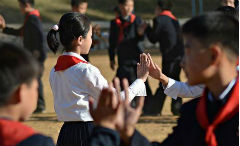China steps up efforts to promote education fairness
2017-09-07
Xinhua
BEIJING —A total of 425 million grants totaling nearly 700 billion yuan ($107 billion) were made to students from 2012 to 2016, the Ministry of Education (MOE) announced on Sept 6.
The sum increased from 112.6 billion yuan in 2012 to 168.9 billion yuan in 2016, a raise of nearly 50 percent.
The growing number of grants is just one aspect of improving educational equality.
On Sept 5, the General Office of the State Council moved to control the dropout rate of students.
By 2020, the percentage of students who drop out of school during the nine-year compulsory education period is set to fall to less than 5 percent.
The dropout rate stood at 6.6 percent in 2016. Most of these come from a few rural areas, particularly border and ethic minority regions, where poverty is a major factor, according to the MOE.
Support for rural teachers acknowledges that remote and poor areas in central and western regions are the weakest links in the education system.
Information technology can make more high-quality educational resources accessible to rural schools, which have been improved to make them more attractive to students.
Poverty relief work is also stemming the number of students who drop out of school for financial reasons.
Support is available to students with financial difficulties and those with disabilities or with disabled parents.
The MOE is seeking more investment in education, better planning of school buildings and more boarding schools for rural students with transportation problems.
Employers are not allowed to hire children under the age of 16 and parents or guardians of school-age children must make sure that students finish compulsory education, or be held accountable under the Compulsory Education Law.
In higher education, quotas are reserved specifically for students from disadvantaged backgrounds. China’s elite universities have been told to reserve vacancies for 63,000 students from disadvantaged rural areas in their 2017 enrollment.
The best universities are included in another program to ensure no less than 2 percent of their students come from disadvantaged rural areas.
These programs have already made a difference. At Renmin University, the percentage of freshmen from rural areas increased from 14.7 percent in 2011 to 18.6 percent in 2016.

